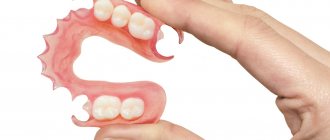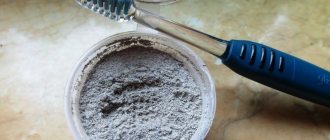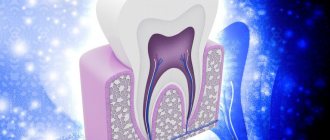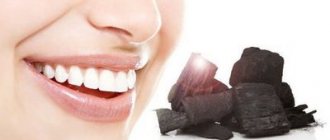Some people use the services of a dentist to change their appearance. The procedure for extending fangs is popular. Adding fangs to healthy teeth allows you to create a vampire look. Before extensions, you should familiarize yourself with the contraindications and possible consequences. You should first weigh all the pros and cons.
Why canine extensions are performed, indications
Any adult has four fangs in his mouth - two at the top and two at the bottom. Visually, they are practically no different from other teeth. Some young people, fans of mysticism and the aesthetics of vampirism, turn to the dentist for fang extensions. The procedure allows them to bring their image closer to that of a vampire.
There are also certain medical indications for canine extensions. Only a dentist can prescribe such extensions. The technique is safe and can be performed by almost anyone. There are several ways to lengthen teeth, in most cases the direct method is used. The length of the extended tooth should not exceed 4 mm. It should be taken into account that an elongated tooth in the mouth can create discomfort and there is a risk of injury to the mucous membrane.
Indications for the procedure:
- therapy - extensions are carried out in case of chips or damage to the crown;
- aesthetic goal - whether there is a need to change the size or shape of the tooth;
- orthopedics - extension is carried out when a tooth is completely destroyed and needs to be restored.
The choice of augmentation technique depends on the indications.
A tooth has broken off and is cutting my tongue. Can I sharpen it with a nail file at home?
When there is a lot of stupidity, you can do anything.
They used a file to file their nails; it was unlikely that it was processed after each use. There are all sorts of microbushes there. And we are thinking of putting this nail file into our mouths. But even if the file is clean, is it worth putting it in your mouth? No dentist will recommend filing chipped teeth at home with nail files. Even if its edges cut your tongue or cheek. The doctor will say that this is unhygienic, dangerous, pointless. And that by filing your teeth, you can turn things around in such a way that there will be even more pain. Damage the enamel, grind down the wrong surface, after which it will be impossible to eat or sleep at all.
But anyone who has had their teeth chipped knows how unpleasant it can be. The tongue or cheeks can be cut so that a real wound is formed. And no painkillers will help. The tooth itself may not hurt, but the mucous membranes around it may be seriously injured.
I agree with people who will say that in the most urgent cases you can try. When there is no one to go to and it is no longer possible to endure. But don't do it as decisively as you want. Process the tool.
If it is difficult to stop a person, the pain is so strong and the determination to file the disturbing tooth on your own drowns out the voice of reason, even use your filing tool.
Wash the file thoroughly with alcohol or at least hot water and soap. Rinse multiple times, not just once. And only after this procedure, start cutting off the sharp pin. If you feel that the file is touching a nerve, you will have to complete this manipulation and go “confessingly” to a good dentist.
If a tooth breaks off. The best recommendation is to see a dentist. The fact is that you are unlikely to be able to determine on your own the severity of the damage. Possible infection can lead to unpleasant consequences and the result will be that “the miser pays twice.”
Treating a tooth yourself is not a good idea. Especially sharpen it with a nail file. Now it is unknown what the nail files are made of. And if you examine a nail file under a microscope, you can see a lot of harmful things. And the file is intended primarily for hands and feet.
So sharpening a tooth with a file is not a good idea. You can introduce some kind of infection into your mouth and it will only get worse. Either the lips will swell, or the herpes will pop out. So the best decision if a tooth chips is to wait until the morning and go to the dentist. He will do everything quickly and reliably
Although, if your tongue really cuts the tooth, take a file and carefully sharpen it. The main thing is not to let the nail file touch your tongue and lips. If, however, you have the patience to endure and still go to the dentist, I wish you good doctors as in the photo below. The main thing is positive, and then pain)
Theoretically, it is very possible to sharpen a chipped tooth. That is, you can round the sharp edge, make it less cutting, and save yourself from the suffering that can be caused by constant mechanical friction of the fragment against the tongue.
It is absolutely clear that this method is not professional, not sterile, not a panacea, and generally not acceptable. But if we don’t academicize the situation and assume that if we don’t take independent emergency measures (being, for example, in a dense forest with a nail file in our hands and without a dentist in our pocket), we can lose a healthy tongue in a few days or a normal psyche from pain, then Of the two emerging evils, you need to choose the lesser. And then, armed with a file treated with alcohol, intuition and a mirror, you can make several movements on the tooth. May I help. And they don’t do such manipulations when there is no other way out.
No, you shouldn’t do this, when my tooth chipped, I went to the dentist, fearing that he might put a filling or something, but he just palpated it for me, now it doesn’t cut and it doesn’t hurt to drink cold/hot water, you shouldn’t do it with a file it can be dangerous, you may get to the nerve, make it worse, go to the dentist (my advice to you).
Can. There is absolutely nothing wrong with this. Otherwise you will continue to suffer. File off the sharpest edge (just use a file several times, it’s easy), the dentist will do the rest when you get to him.
Theoretically, it is possible - the tooth is not an appendix, although people even cut it out for themselves, being far from civilization - at the North Pole - there are no surgeons there, there are no clinics. There was no way out - the man cut it out for himself. And everything went well.
But with a tooth - it seems possible, but suddenly an open nerve forms there - the tip is not cut off, but another piece of the tooth breaks off. Or an already open nerve, then you can run into terrible pain!
On the other hand, the file must be impeccably sterile so that, God forbid, it does not cause an infection!
You can very carefully try to see what it feels like, is there any pain, sharpen the tooth and everything will be fine! But the main thing is not to get infected!
I can tell you from my stupidest experience: once a tooth fell off, I didn’t go to the dentist, the tooth crumbled and began to hurt terribly. I was sick because of the root. And there was such a desire to take something thin and sharp, climb into the cavity and at least clean everything there a little. I know - this is very stupid, especially - not the Far North - there is an avalanche around dentists - you pay money - they will politely and carefully solve the problem with your tooth! There are pharmacies nearby - if the pain is severe, there are plenty of painkillers.
Advantages and disadvantages
Fang extensions have certain advantages and disadvantages. Advantages of the technique:
- aesthetics;
- durability;
- the possibility of full restoration - restored fangs become natural;
- no load on neighboring teeth;
- the ability to choose a shade;
- painlessness - there are no discomfort during canine extensions;
- the opportunity to change the image.
Flaws:
- high price - often due to the need for additional procedures;
- the possibility of redistributing the load during chewing, which will lead to damage to other teeth;
- risk of injury to the oral cavity due to a canine broken during chewing;
- unpredictability of expectations from the procedure - some patients are pleased with their fangs for a short period of time;
- impossibility of tooth extension in the presence of a partially damaged root.
Options for teeth filing procedures
In some cases, your dentist may tell you during treatment that it would be advisable to file your teeth. There are controversial opinions about this procedure - some experts believe that it harms the teeth, others say it is completely safe. In this article we will try to figure out whether filing is harmful, whether it can be done, and in what cases a part of the tooth is ground down.
Contraindications
Fang extensions are not recommended in the following cases:
- severe abrasion of tooth enamel;
- signs of periodontitis;
- defects in the root region;
- malocclusion - shifting the load during chewing can lead to excess pressure on individual elements;
- failure to comply with oral hygiene rules;
- allergic reactions to materials used in extensions.
Ignoring contraindications can lead to serious damage to the chewing teeth. Before the procedure, it is recommended to eliminate all of the listed defects.
Possible complications
If we talk about complications of tooth sharpening, then, first of all, it is a reaction expressed in increased sensitivity of the enamel after surgery. This usually goes away within a week. If the sensitivity does not go away, you should contact the dentist who did the filing. As a rule, no more complications arise if the operation was performed by a qualified specialist and not by an amateur.
Increased sensitivity is the effect of dentin, which is located under the enamel. It passes through many channels. They contain nerve endings. When the thickness of the enamel layer decreases, the pressure changes, resulting in pain from hot or cold drinks and foods. During adaptation, dentists advise not to eat solid foods, very cold or hot foods, or highly acidic drinks.
Preparation
Extension of fangs requires preliminary preparation. Preparatory procedures are divided into preliminary (optional) and immediate (mandatory).
Preparation may include the following procedures:
- Professional cleaning of tartar, plaque and dirt. The procedure allows you to set the actual shade of enamel for choosing a material. The specialist must take into account the different colors of the base and edges of the tooth.
- Treatment of caries is a mandatory procedure.
- Taking impressions allows you to determine the best tooth shape.
- Canine preparation is carried out before applying the composite material. The procedure ensures tight fixation of the composite on the tissue. The part being built up will receive additional thickness.
- Grinding of hard tissues - allows you to give the tooth a natural shape. Care is taken during the procedure to avoid damage to the internal layers and eliminate pigmented areas of dentin.
Possible complications
If we talk about complications of tooth sharpening, then, first of all, it is a reaction expressed in increased sensitivity of the enamel after surgery. This usually goes away within a week. If the sensitivity does not go away, you should contact the dentist who did the filing. As a rule, no more complications arise if the operation was performed by a qualified specialist and not by an amateur.
Increased sensitivity is the effect of dentin, which is located under the enamel. It passes through many channels. They contain nerve endings. When the thickness of the enamel layer decreases, the pressure changes, resulting in pain from hot or cold drinks and foods. During adaptation, dentists advise not to eat solid foods, very cold or hot foods, or highly acidic drinks.
Extension methods
There are several ways to grow fangs in dentistry. The choice depends on the condition of the teeth, clinical picture, and patient preferences.
Direct method
The direct method of extension is the most gentle. All manipulations are carried out directly in the patient’s oral cavity. The composite material is applied to the teeth in layers. The final stage is grinding and polishing. The selection of parameters is carried out taking into account the characteristics of the dentofacial apparatus. The procedure is similar to nail extensions. The duration of the procedure does not exceed 2 hours. It is worth noting that fangs grown with reflective material do not darken over time and are compatible with living tissues. Stages of extension:
- turning of hard tissues - the procedure allows you to create the shape of a fang;
- surface insulation - latex fabric with a hole for the fang will help prevent moisture from entering;
- enamel conditioning - increases the adhesion strength of composites to the tooth;
- application of adhesive systems - ensures a strong connection of composite materials with dentin.
- layer-by-layer application of the composite - it all depends on the desired shape and degree of tooth destruction;
- grinding and polishing;
- highlighting - the procedure accelerates the hardening process of the composite.
When using composite materials for restoration, you should be aware of certain features of the technique. The degree of porosity may exceed the porosity of tooth enamel. This requires two precautions. First of all, for several days after the procedure, you should avoid eating foods and drinks with coloring components in their composition. The second mandatory condition is professional hygiene twice a year. Thorough polishing will help preserve the original shade of the fangs.
Veneers
Veneers are ultra-thin overlays that are attached to the teeth from the front. Their thickness is 0.5 mm. Overlays allow you to correct darkened enamel, defects, chips, diastemas, cracks. After their installation, the teeth take on the desired shape. The procedure is carried out after grinding down the enamel layer, thereby ensuring strong adhesion. Veneers are either composite or laboratory-made. The service life of the plates reaches 101-5 years. Stages:
- grinding down the enamel - a specialist applies special grooves to fix the onlays on the teeth;
- preparation of casts;
- installation of temporary plastic overlays;
- installation of permanent veneers using cement.
Composite veneers are created in one session in the dental chair. The material is applied in layers. The second method is less durable; such veneers require regular polishing.
Lumineers
Lumineers are ultra-thin overlays. Their installation does not require preliminary preparation of the tooth. Dental porcelain with minerals is used in the manufacture of plates. Overlays allow you to hide color defects and blemishes. And it can be removed, no need to grind off the enamel. The installation procedure only takes a couple of procedures. At the first visit, the patient is examined, the dentist listens to the patient’s wishes and offers options. The impression taken is sent to the laboratory. Next time, the doctor installs ready-made lumineers on a previously cleaned tooth.
Stump tab
Fang augmentation is also carried out in case of a damaged tooth. When restoring a tooth that has broken away from the base, it is recommended to use a core inlay. Metal alloys, zirconium dioxide, ceramics, and plastic are used in manufacturing. Ceramics and zirconium have excellent characteristics. They look great, are durable, and do not destroy surrounding tissue. When making core inlays, individual parameters are taken into account; everything depends on the shape of the tooth being restored. The dimensions should not exceed the size of the teeth; a composite is applied on top or a crown is fixed. The recovery procedure takes up to a month. Stages of installing the stump tab:
- removal of damaged tissue, expansion of channels;
- taking an impression for the inlay;
- installation of the structure using dental glue;
- creating a layout for the crown;
- fitting, choice of color for crowns;
- coating application;
- fixation of the finished crown.
Artificial crowns
Prosthetics is the most radical method. The patient should be warned that there is no reversal after the crowns are installed. The method is labor-intensive; extensive tissue preparation is first carried out. Artificial crowns are made taking into account the characteristics of the dental system. Crowns can be installed on ground teeth, pins, stump inlays. Stages of making fangs:
- At the initial stage, an impression is made. Based on this, a specialist works in laboratory conditions to create a fang. Gypsum is used as a test material.
- Trying on, adjusting the layout, sending the cast for revision if necessary.
- Installation of a temporary structure for 2 weeks.
- Choice of material - the artificial tooth is made of zirconium dioxide, metal ceramics. The first option is in great demand due to its strength, wear resistance, and aesthetics.
- Making a new crown and fixing it with cement.
Care
Immediately after growing the fangs, the dentist applies a special varnish to them. It provides protection. The layer helps prevent damage to the material from external factors (dyes, high temperatures). Dentists recommend growing fangs at the age of no earlier than 16-18 years.
Extended teeth require certain care. Compliance with hygiene rules and dentist recommendations will help avoid caries and other problems.
Recommendations:
- twice daily brushing of teeth;
- use of non-abrasive paste, soft and medium brush;
- refusal of coffee, smoking, strong brewed tea;
- regular preventive dental examinations, timely response to pathological symptoms.
Alternative ways to straighten teeth
There are several alternative methods for correcting dentition in modern medicine. The most common ones are:
- Orthopedic mouthguards. Made from plastic or silicone. They are convenient because they can be quickly removed at any time. This makes it easier to perform hygienic actions and eat food. They look aesthetically pleasing and are almost invisible in the mouth (they are mostly transparent).
- Aligners. Such devices are suitable even in advanced situations (severe crowding, curvature). It is noteworthy that when worn, the patient practically does not feel them and does not experience irritation.
- Trainers. They are used to treat children under 12 years of age; for minor curvatures, they must be worn for about 2 years. They are also used to consolidate the result after using braces and caps. Grinded incisors can be straightened by filling and using cosmetic procedures.
Possible consequences
Even following the rules does not guarantee the absence of negative consequences in the future. The cost of canine extensions is another barrier.
Possible negative consequences:
- Caries - develops as a result of injury to the enamel. Violations of the integrity of the dental covering threaten caries. Instead of vampire fangs, black carious spots may form, which will ruin all expectations.
- Increased tooth sensitivity to temperature and foods with different tastes. Forced filing of enamel always leads to increased sensitivity. Discomfortable sensations can occur even when inhaling cold street air.
- Discomfort while eating. The canines are designed for biting and crushing food, then it goes to the molars for further grinding. Artificially lengthened canines may lose functionality. Poor quality chewed food can lead to the development of gastrointestinal diseases.
- Risk of chipping. Extended fangs lose their hardness; they can break even when chewing a small cracker. When a large amount of enamel is removed, the likelihood of complete tooth destruction remains.
- Discomfortable sensations in the oral cavity. Long fangs pose a danger to the lips and gums, and problems may arise when closing the jaws. The inability to close the mouth leads to increased salivation, which has little to do with the image of a predatory vampire.
Possible complications
If we talk about complications of tooth sharpening, then, first of all, it is a reaction expressed in increased sensitivity of the enamel after surgery. This usually goes away within a week. If the sensitivity does not go away, you should contact the dentist who did the filing. As a rule, no more complications arise if the operation was performed by a qualified specialist and not by an amateur.
Increased sensitivity is the effect of dentin, which is located under the enamel. It passes through many channels. They contain nerve endings. When the thickness of the enamel layer decreases, the pressure changes, resulting in pain from hot or cold drinks and foods. During adaptation, dentists advise not to eat solid foods, very cold or hot foods, or highly acidic drinks.
Price
The price depends on factors such as quality, volume of material, and prices. Dentistry, the level of qualifications of the doctor, additional services also affect the price. Extension will cost from 4,000 -5,000 rubles. up to 30,000 -40,000 rub.
Standard restoration 4,000-5,000 rubles. This price does not include caries treatment, cleaning, etc. Installing a ceramic composite veneer will cost at least 20,000 rubles. Ceramic, zirconium prosthesis - 25,000-30,000 rubles. for 1 piece Lumineer costs 45-65 thousand rubles. For a metal-ceramic crown you will have to pay 15,000-20,000 rubles. A zirconium crown costs 20,000-25,000 rubles.
Before adding fangs, you should think several times, study the proposals, and weigh the risks. This method will help to greatly change the image, the appearance will become original. The procedure may affect the condition of the teeth and oral cavity. Correction poses a danger to tooth enamel. The situation is aggravated if there are contraindications or violation of the rules of the procedure.
Why canine teeth often grow crooked or do not erupt completely?
Formation of the correct sound pronunciation of hissing sounds in preschoolers at home
For most children, “threes” are the very last to appear - closer to ten or twelve years. Because of this, it may turn out that there is no place for them. Then they begin to grow higher than necessary, behind or in front of their neighbors.
Another common problem with crooked eye units is the discrepancy between the size of the teeth and the width of the jaw. This phenomenon is quite common - a child may inherit a small jaw from one parent, but large, large teeth from the other.
The third cause of dental anomaly is the delayed replacement of milk units with permanent ones. There is no way to influence her. You just have to eliminate the consequences of deviation.
Temporary fangs - an alternative
If you have any doubts about the need to lengthen your canines for life, pay attention to temporary ones. You can always put them on for a while and take them out if necessary. They are absolutely safe and are attached to teeth absolutely safely. Temporary fangs can be used for Halloween. Ready-made teeth are sold in the store. You can also make the decoration yourself.
It is necessary to take plastic utensils, ground plastic, and place boiling water from the floor. The soft material must be carefully taken with a metal spoon and molded into a fang of the desired shape. Gloves will help avoid burns.
Temporary fangs can also be made from plastic straws, acrylic, or plastic nails. Such fangs do not last long, but they allow you to feel like a vampire and create an excellent image for a holiday or performance.











